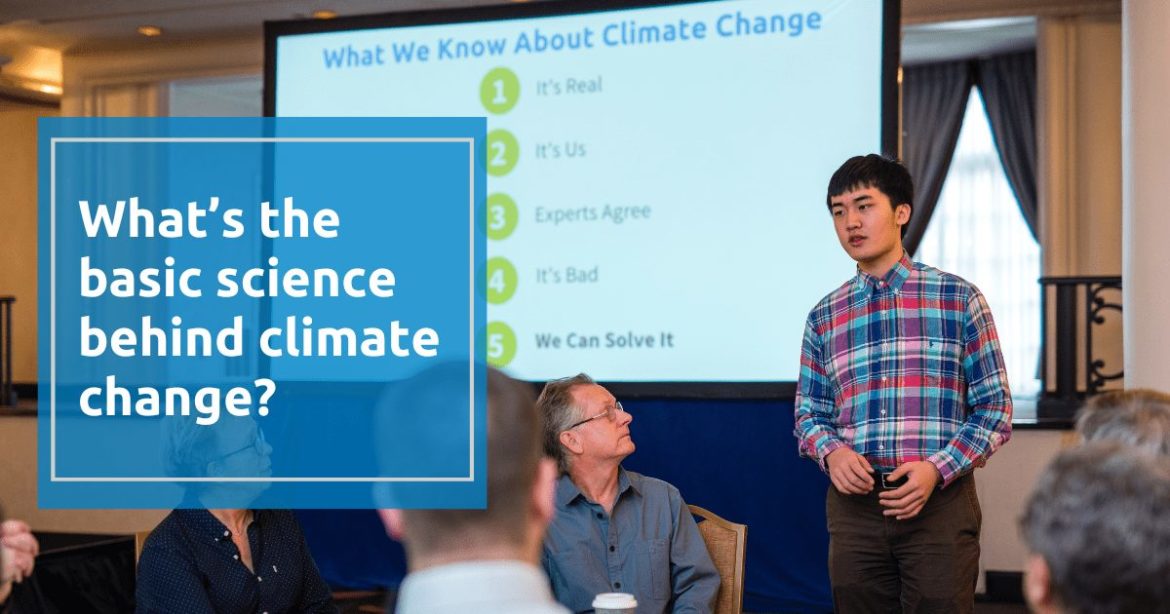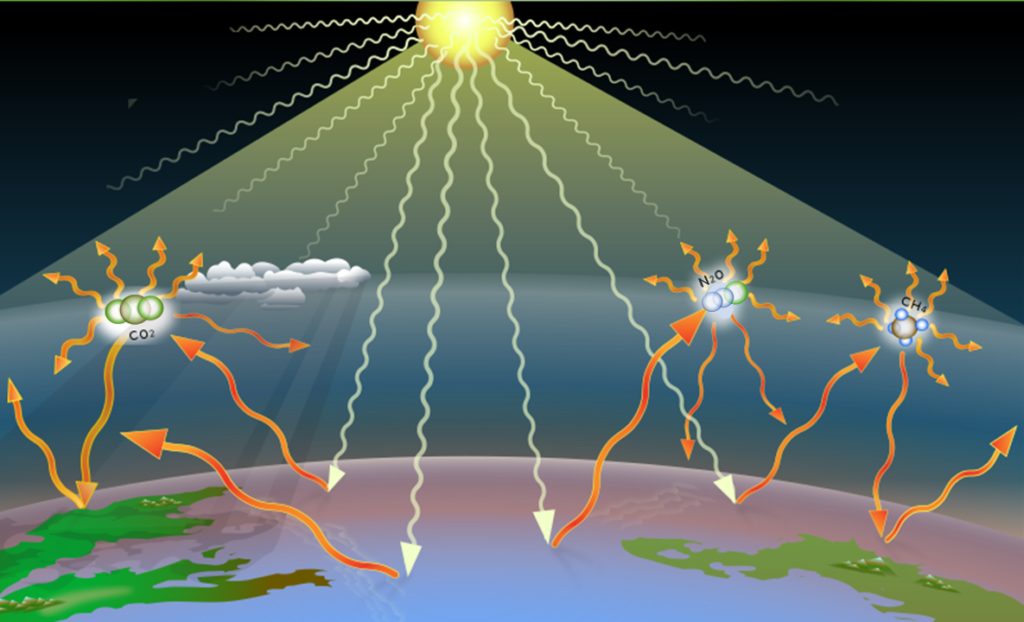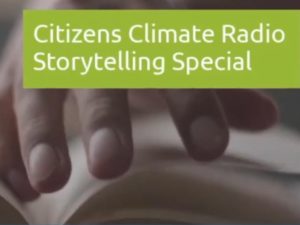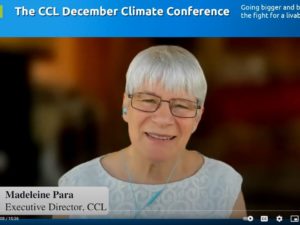
By Rick Knight
Question: What is the science of climate change?
Answer: The sun heats the earth, which then radiates part of that heat back into space as infrared radiation. Certain gases – ‘greenhouse gases’ – interact with this outgoing heat radiation, returning some of it back to the surface and keeping its temperature higher than it would be without them. Although water vapor has the greatest overall effect, it’s really carbon dioxide, CO2, that plays the pivotal role. If there was no CO2 in the atmosphere, most or all of the earth’s surface would be frozen, but just a tiny amount keeps it warm enough to support life as we know it.
For about 10,000 years, atmospheric CO2 levels have been quite steady, giving us a stable climate in which to live and grow. But as we learned how to extract energy from coal, oil, and gas, we went on to burn them, faster and faster, converting ‘fossil’ carbon that’s been buried for millions of years into CO2, pouring it into the atmosphere and exceeding the natural level that our ecosystems had maintained for millennia.
Climate scientists have understood the greenhouse effect since the 1850’s, but it wasn’t until 1958 that one scientist, Charles David Keeling, began regularly measuring and tracking atmospheric CO2. Just since that time, it’s climbed by more than 30 percent, about 100 times faster than any natural cycle can explain.
Not only is this raising the global temperature, but a sizable fraction of the CO2 we produce is going into the oceans, causing the water to become more acidic. That’s detrimental to important marine life upon which 10 to 12% of the world’s population depend.
Human activity, mostly fossil fuel burning, currently adds over a thousand tons of CO2 per second to the atmosphere and the oceans. Natural cycles, volcanoes, and the sun have all been ruled out as the cause of the current heat buildup. They are either too small, too slow, or going in the opposite direction. It’s us.
In a Nutshell: Global temperatures are now rising at an accelerating rate, which began in the 1800s. This is entirely due to greenhouse gas emissions buildup from human activity, mainly the burning of fossil fuels.
Learn more: Why is it so hot?
Deeper dive: Public appreciation of the dangers associated with climate change has grown since it first crashed onto the national scene with Dr. James Hansen’s 1988 Senate testimony. But even now, how this phenomenon works still remains a mystery to many, and where mysteries persist, misinformation thrives.
Graphic adapted from Wikimedia Commons
Energy Ins and Outs: The energy that makes life on earth’s climate possible comes from the sun, mostly as visible light (the pale yellow squiggles in the graphic above). Some of it is reflected back to space by Earth’s surface and clouds, but most of it warms the surface. On the nighttime side, the planet radiates some of that heat back into space as infrared light (the red-orange squiggles). Most of the gases in the atmosphere – nitrogen, oxygen, and argon – don’t interact with that outgoing heat radiation. But certain ‘greenhouse’ gases (GHGs) – do. As shown above, these include carbon dioxide (CO2), nitrous oxide (N2O), and methane (CH4).
Photon gobblers: All forms of light, including infrared, consist of tiny packets of energy called ‘photons.’ When an infrared photon radiating away from the earth happens to hit a GHG molecule, that molecule gobbles it up and goes into what’s called an ‘excited’ vibrational state. But that only lasts for an instant, after which the molecule spits out an identical photon in a random direction. That’s the key: since that new photon could go in any direction, it may continue out to space like the original one, but there’s an even chance it will go back down toward the earth, returning that energy back to where we all live. So, the more GHG molecules there are in the air, the more of the outgoing infrared energy effectively gets bounced back to the Earth’s surface. The equilibrium between ingoing and outgoing energy changes, and that’s what gradually raises the average global temperature.
Strength in numbers: Because of differences in their chemistry, the various GHGs absorb and re-emit different amounts of energy. Here’s a handy table that shows the difference in heat trapping power between these gases, but also shows how the concentration of CO2 overwhelms that difference because there is so much more of it.
| Greenhouse Gas | Heat trapping power (relative to CO2)* |
Concentration (per million in air)** |
| Carbon dioxide (CO2) | 1 | 420 |
| Methane (CH4) | 83 | 2 |
| Nitrous oxide (N2O) | 273 | 0.3 |
* by mass, over a 20-year time span
** as of Jan 2023
Consequently, CO2 is the pivotal component that drives climate change. As noted earlier, if there was no CO2 in the atmosphere, most or all of the earth’s surface would be frozen. But just a tiny fraction – around 0.03% – is enough to keep earth at a nice stable temperature of around 60°F, allowing human civilization to flourish.
One climate myth argues that water vapor, not CO2, is actually responsible for global warming. That’s false, because while water vapor indeed is a greenhouse gas, it has a special property that regulates its buildup in the atmosphere: as temperature changes, it can change quickly from gas (water vapor) to liquid (clouds, fog, or precipitation) or back again. The other greenhouse gases don’t do this. Plus, the warmer the atmosphere, the more water vapor it can contain. So, far from causing global warming, water vapor thus amplifies the global warming caused by CO2 and other greenhouse gases.
Steady as she goes: For the last ten thousand years or so, atmospheric CO2 levels were quite steady, giving humanity a stable climate in which to live and grow and progress. But a few hundred years ago, we discovered that we could extract tremendously useful energy from fossilized carbon – first coal, later oil and gas – that’s been buried for hundreds of millions of years. These highly concentrated energy sources allowed us to do and create things never before possible.
What could go wrong? It turned out that converting all that fossil carbon into CO2 would slowly but surely swamp Earth’s ability to keep its concentration at the equilibrium level we had had for millennia. Scientific understanding of the greenhouse effect first emerged in the 1850s, but it wasn’t until 1958 that we began regularly measuring and tracking atmospheric CO2 (see below). Just since that time, it’s climbed by more than 33 percent, about 100 times faster than any natural cycle could explain.
Graphic from NOAA
There is no way this disruption in atmospheric chemistry could not affect global temperature and the weather patterns that are so intimately linked to it.
The other climate change: Not only is this greenhouse effect raising the global temperature, but a sizeable fraction of excess CO2 is going into the oceans, causing the water to become more acidic (a.k.a. “ocean acidification”). That’s detrimental to important marine life, and the damage it causes can cascade throughout the food chain.
The bottom line: Human activity adds about 50 billion tons of GHGs to our ecosystems every year. Three quarters of that is carbon dioxide from fossil fuels, which is over a thousand tons per second. The rest is a combination of methane (from agricultural, industrial, and land use changes), nitrous oxide (from agricultural and industrial sources), and some industrial chemicals. That leads directly to excess heat buildup, which is leading to changes in our living conditions that are overwhelmingly harmful. Natural cycles, volcanoes, and the sun have all been ruled out as the cause of that buildup. They are either too small, too slow, or going in the opposite direction. So the finger points at us. That’s why we have to take action to reduce climate pollution. It’s not just for the polar bears or some ideological vision of how people should run their daily lives; it’s a matter of preserving livable conditions and a thriving economy for future generations all around the world.
Video: Explaining the Science of Climate Change
Volunteer and help fight climate change today







